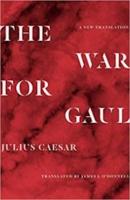
Princeton (2019) h/b 275pp £22.00 (ISBN 9780691174921)
One wonders what millennials know and make of Julius Caesar and his career. Iconic, of course, is (or isn’t) the word, and Adrian Goldsworthy’s fine biography is an option for this generation’s readers. But for many of us baby boomers, Caesar was part of the scholastic furniture, and certainly, in a boys’ grammar school like mine, the remove was Caesar’s year. I knew the set book by heart. I heroised him. The establishment was still clinging to him as exemplary of all that was right about colonialism, and our duty as superior beings to bring civilisation to the less fortunate, less knowledgeable and probably more hairy.
But when a few years later I ended my working life back in school, he was, of course, nowhere to be seen. Yet I still could not expunge that image, drawn from a ‘60s American Dell comic (it would be called a ‘graphic novel’ now) of Caesar in full cry, red cloak afloat behind him, heading for the crisis point at Alesia, with troops in the background mouthing something like ‘Jeepers, there goes the boss. Better back him up!’
So what is O’D. bringing to the table with a new translation of The Gallic Wars? Perhaps, along with the translation, a fresh Caesar, a revisionist account of the man and his actions? The answer is a bad man doing bad things to perfectly decent people for the worst of possible reasons. O’D. has no compunction about expressing his personal dislike.
The book, like all Gaul, is divided into three parts. First, there is a lengthy introduction introducing us to the republic from about 90 BC; the nature of Gaul and Caesar’s war there; Caesar himself and his motivations; O’D.’s approach to producing a new translation. He uses fewer words than most to try and capture the unadorned narrative drive: ‘I translate … it in a way that brings over into English the force, effectiveness, and conciseness of what he said. Caesar was never chatty or helpful, and I’ve tried to emulate him’.
Secondly, each commentary has a short introduction on what was really going on in the campaign itself and the politics at home that directed Caesar’s approach. And thirdly, there’s the translation itself. The virile, even clipped approach works: ‘Gaul is divided, all in three parts: Belgians live in one, Aquitanians in another, and people called Celts in a third (we call them Gauls)’. To compare C.’s approach to that of a ‘Tutorial University Press’ crib, it is fascinating how the latter preserves the grammatical structure of Caesar, whilst the former gets closer to the great man’s intent.
Certainly one for the school library shelves or young friends and relatives (classicists or no) who may well be less acquainted with Caesar. And a chance to observe how they deal with the idea of such a brilliant, world-class, charming genocidalist. It comes with a chronology, a map of Gaul, suggestions for further reading, and an index.
Adrian Spooner
